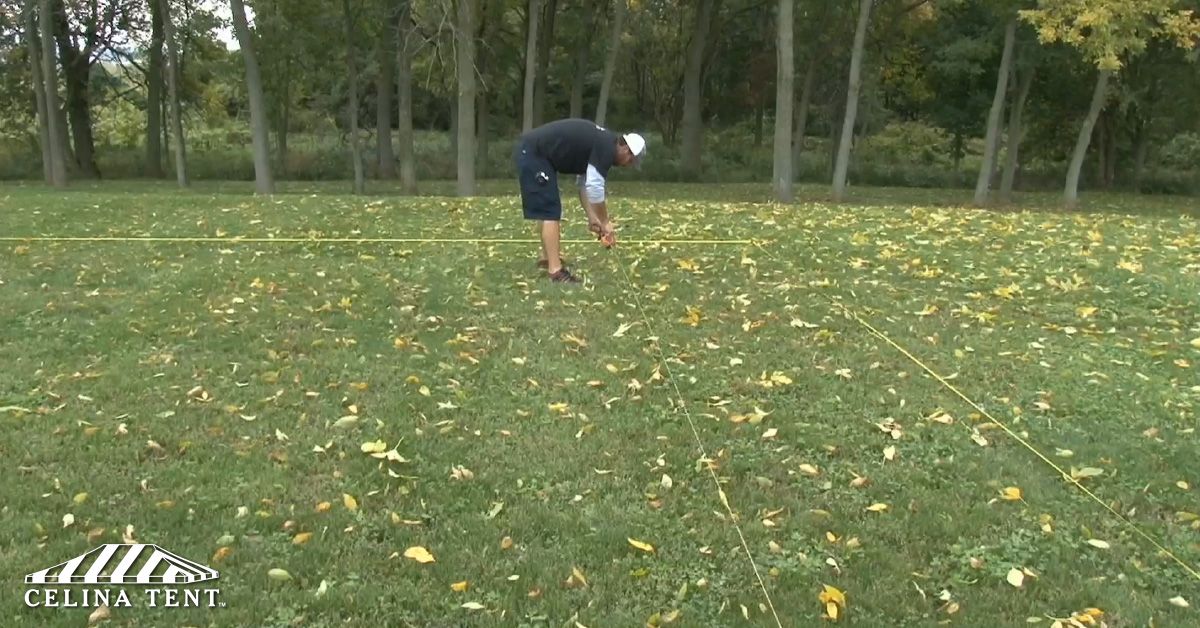There are secrets to every trade. From unique recipes at restaurants to pre-sporting event rituals, everyone has a process or special method for achieving their desired end goal. Tenting is no exception. While much of our manual and video instruction is focused on exactly what you need to do to get your tent set up properly, there is one step that cannot be forgotten – tent squaring.
At Celina Tent, we know that it can seem a little bit like overkill, especially when the tent you are installing is on the smaller end (say, 10’ or 12’ square). However, it is important to note that even the smallest fabric shelters can wear prematurely due to a misaligned installation. In the interest of protecting your investment, proper tent squaring should be performed before any tent setup.
4 Tools for Proper Tent Squaring
Of course, walking out into a field and eyeballing it isn’t going to cut it. Common squaring requires:
2 300’ (91.5 m) Measuring Tape
4 Pins or Spikes
Masonry String
White Marking Paint
You will also need to know the dimensions of your tent, the approximate staking length, and the Pythagorean Theorem.
Tent Dimensions
This should be the simplest to find; on Celina tents, the size of the tent is listed on the tent’s label.
Staking Length
Staking Length refers to the distance out from the edge of the tent to where the actual support stakes will be installed. Celina recommends that tents with an eave height of around 7 or 8 feet (2.1-2.4 m), staking should lie around 5’ (1.5 m) out. This will come into play during measuring.
Pythagorean Theorem
A2 + B2 = C2 is the formula used to calculate the hypotenuse of a right triangle, which is what we’re going for. With the tent footprint divided into halves, this ensures that the corners will be 90 degrees and the sides straight. Celina offers a chart that allows you to simply look up the distances according to footprint dimensions, but it never hurts to understand the method behind procedures.
Tent Staking Directions
1. The first step is to know how you want your tent laid out; if there is a particular side you want a parallel to a building, road, or pathway, start there. Both measuring tapes are pinned at your starting point, which will be one corner of your installation. You will be measuring and marking for the staking on your tent; be sure to add the staking length to your tent dimension (let’s assume it’s a 20’ x 40’ tent), accounting for staking on both sides.
Example: Tent Width (20’) + Left Staking (5’) + Right Staking (5’) = 30’ Side Dimension
2. Take one measuring tape and walk it the full distance for that side of the installation, inserting a pin at that location. Now it’s necessary to know the distance from the first pin – our starting corner – and the corner diagonal across the tent. You can find this by either using a distance chart or by using the Pythagorean Theorem. Assuming we don’t have the chart, we will take the two tent dimensions to calculate the diagonal.
Example: Width with Staking (30’)2 + Length with Staking (50’)2 = Diagonal2
900 + 2500 = Diagonal2 3400 = Diagonal2 58’ 3.5” = Diagonal
3. The first measuring tape will continue to be pulled out, to the point where it measures both sides of the tent footprint. In this case, 30’ + 50’, or 80’. Then the second measuring tape is drawn out to the length of the diagonal, 58’ 3.5”. Once you’ve gotten the distances on the tapes, match them so that both are pulled tight against the pins and you’ll have the third corner. Repeat this process, relocating the ends of the measuring tapes to the second pin, to locate the final corner.
The Benefits of Tent Squaring
The squaring process is vital to the success of any tent and becomes all the more important as the size of the
Celina offers many resources to make tent squaring simple, from instructional videos including individual tent styles and sizes to measurement charts, to complete squaring kits for sale with our tents. Have questions about squaring your tent? Chat with a member of our highly trained customer support staff –available 24/7—at www.gettent.co.uk.

Keeping your Tents Squared Away Throughout the Install Process